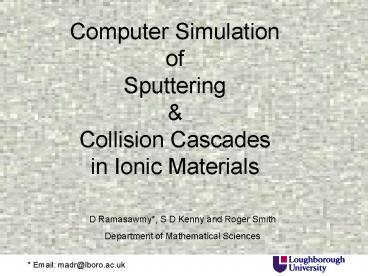Computer Simulation of Sputtering - PowerPoint PPT Presentation
1 / 12
Title:
Computer Simulation of Sputtering
Description:
D Ramasawmy*, S D Kenny and Roger Smith. Department of ... Computer Simulation of Sputtering of NaCl by impact ... Vacancy (Cl- ion) Grey Vacancy ... – PowerPoint PPT presentation
Number of Views:99
Avg rating:3.0/5.0
Title: Computer Simulation of Sputtering
1
Computer Simulation of Sputtering
Collision Cascadesin Ionic Materials
D Ramasawmy, S D Kenny and Roger
Smith Department of Mathematical Sciences
Email madr_at_lboro.ac.uk
2
Outline
- Sputtering Definition, History Applications.
- Computer Simulation of Sputtering of NaCl by
impact with a Na ion. - Use of DPMTA code Order (N) to evaluate
Coulombic interactions. - Collision Cascades in NaCl.
DPMTA http//www.ee.duke.edu/Research/SciComp
/Docs/Dpmta/dpmta.html
3
Sputtering
Definition
- Sputtering is the removal of surface atoms due to
energetic particle bombardment. - This is caused by collisions between the incoming
particles and the atoms in the near surface
layers of a solid.
History
- The first recorded observation of sputtering was
made by W R Grove 150 years ago.
Applications
- Sputtering is not just an unwanted effect which
destroys cathodes and contaminates plasmas. - It is used in many modern industrial processes
including surface cleaning and etching, thin film
deposition, surface and surface layer analysis.
W R Grove, Philosophical Transactions, vol
142, page 87, 1852.
4
MD Methodology
- Target a NaCl lattice
- System size 1944 particles
- Impact particle a Na ion at normal incidence
with energy of 1 KeV - Fixed boundary conditions were taken along the
sides while the top and bottom surfaces were
free. - Several hundreds of trajectories with run-time
of 2.0 ps were carried out for different impact
positions to yield a good statistics. - A particle is considered sputtered if it is
moving away from the surface and it has
sufficient KE to overcome the electrostatic
attraction.
5
MD Methodology
- The electrostatic interactions were evaluated
using a brute force method - The potential used was that of the Buckingham
form as given by Catlow et al. - This potential as given was not suitable for
modelling collisional phenomena. - The Na - Cl- potential was hardened using a
screened coulomb potential to overcome the
over attractive forces for small separation.
C.R.A. Catlow, K.M. Diller and M.J.Norgett, J.
Phys. C Solid State Phys., 10, 1394 (1977).
D. Ramasawmy, S.D. Kenny, Roger Smith, NIMB
(2002).
6
Simulation
- Due to the symmetry of the (100) surface of the
NaCl lattice, we have considered only one quarter
of the area of the surface unit cell.
Cl- ion
From the results, sputtering was observed to
occur only for impacts concentrated around the
Na ion and the Cl- ion. Furthermore, for the
majority of impacts outside these regions,
channelling was observed.
Reduced Impact Zone
Na ion
7
Results
- The overall sputtering yield was determined to
be 0.36 with a variance of 0.01. - The total no of sputtered particles was almost
evenly distributed between the 2 species 51
Na 49 Cl-. - A lower yield of sputtered particles was observed
compared to similar impacts on metals. - The sputtered particles were classified into
groups according to their kinetic energies and
atomic types. - More low energy particles were ejected compared
from metals and semi-conductors. - The origin of the ejected particles is summarised
in the table. It shows a substantial contribution
from subsurface layers.
76.5
6.5
3.3
3.5
4th layer
4.1
6.0
8
Further Results
- The angular distributions show less structure
representative than is typical for sputtering
from metals and semi-conductors. - The majority of trajectories lead to only a small
number of sputtered particles. - The ions are often seen to come off as NaCl
dimers.
9
Movie of Sputtering
- Example of a Computer Simulation of the
Sputtering of NaCl by impact with a Na ion with
1 KeV at normal incidence.
10
Discussion
- We have observed that ionic materials show a
number of characteristic differences from metals
and semi-conductors. They are as follows - a) Lower ejection yields
- b) Larger contribution from subsurface layers
- c) Less well-defined angular distributions
- d) Large number of low energy ejected
particles. - There is a number of features that warrant
further investigation, namely the effect of
bombarding species, the crystal size and cluster
formation.
11
DPMTA
- DPMTA (a Distributed Implementation of the
Parallel Multipole Tree Algorithm) code developed
at Duke University was implemented within our MD
code. - DPMTA is based on the FMM (the Fast Multipole
Method) and was originally developed by Greengard
and Rokhlin. - This method is O(N) meaning that it is faster
compared with the crude method which is O(N2)
and which we used in our initial study. - We are now simulating bigger system sizes and
this will enable us to study sputtering,
collision cascades and other effects in more
detail.
DPMTA http//www.ee.duke.edu/Research/SciComp/
Docs/Dpmta/dpmta.html L. Greengard, V.
Rokhlin, J. Comp. Phys. 82 (1997) 135
12
Collision Cascades
We are currently doing some test simulations on
Collision Cascades. Below is one example in which
a Cl- ion about the centre of a NaCl lattice is
given 250 eV along a certain direction.
Temperature 0 K System Size 5832 particles.
- Legend
- Colours of Spheres
- Blue / Purple Interstitial (Cl- ion)
- Red Interstitial (Na ion)
- Brown Vacancy (Cl- ion)
- Grey Vacancy (Na ion)
Acknowledgements H Hurchand ( Collision Cascades
)































